Vladimir Arkhipkin
Kandinsky 3: Text-to-Image Synthesis for Multifunctional Generative Framework
Oct 28, 2024Abstract:Text-to-image (T2I) diffusion models are popular for introducing image manipulation methods, such as editing, image fusion, inpainting, etc. At the same time, image-to-video (I2V) and text-to-video (T2V) models are also built on top of T2I models. We present Kandinsky 3, a novel T2I model based on latent diffusion, achieving a high level of quality and photorealism. The key feature of the new architecture is the simplicity and efficiency of its adaptation for many types of generation tasks. We extend the base T2I model for various applications and create a multifunctional generation system that includes text-guided inpainting/outpainting, image fusion, text-image fusion, image variations generation, I2V and T2V generation. We also present a distilled version of the T2I model, evaluating inference in 4 steps of the reverse process without reducing image quality and 3 times faster than the base model. We deployed a user-friendly demo system in which all the features can be tested in the public domain. Additionally, we released the source code and checkpoints for the Kandinsky 3 and extended models. Human evaluations show that Kandinsky 3 demonstrates one of the highest quality scores among open source generation systems.
Kandinsky 3.0 Technical Report
Dec 11, 2023



Abstract:We present Kandinsky 3.0, a large-scale text-to-image generation model based on latent diffusion, continuing the series of text-to-image Kandinsky models and reflecting our progress to achieve higher quality and realism of image generation. Compared to previous versions of Kandinsky 2.x, Kandinsky 3.0 leverages a two times larger U-Net backbone, a ten times larger text encoder and removes diffusion mapping. We describe the architecture of the model, the data collection procedure, the training technique, and the production system of user interaction. We focus on the key components that, as we have identified as a result of a large number of experiments, had the most significant impact on improving the quality of our model compared to the others. By our side-by-side comparisons, Kandinsky becomes better in text understanding and works better on specific domains. Project page: https://ai-forever.github.io/Kandinsky-3
FusionFrames: Efficient Architectural Aspects for Text-to-Video Generation Pipeline
Nov 22, 2023Abstract:Multimedia generation approaches occupy a prominent place in artificial intelligence research. Text-to-image models achieved high-quality results over the last few years. However, video synthesis methods recently started to develop. This paper presents a new two-stage latent diffusion text-to-video generation architecture based on the text-to-image diffusion model. The first stage concerns keyframes synthesis to figure the storyline of a video, while the second one is devoted to interpolation frames generation to make movements of the scene and objects smooth. We compare several temporal conditioning approaches for keyframes generation. The results show the advantage of using separate temporal blocks over temporal layers in terms of metrics reflecting video generation quality aspects and human preference. The design of our interpolation model significantly reduces computational costs compared to other masked frame interpolation approaches. Furthermore, we evaluate different configurations of MoVQ-based video decoding scheme to improve consistency and achieve higher PSNR, SSIM, MSE, and LPIPS scores. Finally, we compare our pipeline with existing solutions and achieve top-2 scores overall and top-1 among open-source solutions: CLIPSIM = 0.2976 and FVD = 433.054. Project page: https://ai-forever.github.io/kandinsky-video/
Kandinsky: an Improved Text-to-Image Synthesis with Image Prior and Latent Diffusion
Oct 05, 2023Abstract:Text-to-image generation is a significant domain in modern computer vision and has achieved substantial improvements through the evolution of generative architectures. Among these, there are diffusion-based models that have demonstrated essential quality enhancements. These models are generally split into two categories: pixel-level and latent-level approaches. We present Kandinsky1, a novel exploration of latent diffusion architecture, combining the principles of the image prior models with latent diffusion techniques. The image prior model is trained separately to map text embeddings to image embeddings of CLIP. Another distinct feature of the proposed model is the modified MoVQ implementation, which serves as the image autoencoder component. Overall, the designed model contains 3.3B parameters. We also deployed a user-friendly demo system that supports diverse generative modes such as text-to-image generation, image fusion, text and image fusion, image variations generation, and text-guided inpainting/outpainting. Additionally, we released the source code and checkpoints for the Kandinsky models. Experimental evaluations demonstrate a FID score of 8.03 on the COCO-30K dataset, marking our model as the top open-source performer in terms of measurable image generation quality.
Star-Shaped Denoising Diffusion Probabilistic Models
Feb 10, 2023Abstract:Methods based on Denoising Diffusion Probabilistic Models (DDPM) became a ubiquitous tool in generative modeling. However, they are mostly limited to Gaussian and discrete diffusion processes. We propose Star-Shaped Denoising Diffusion Probabilistic Models (SS-DDPM), a model with a non-Markovian diffusion-like noising process. In the case of Gaussian distributions, this model is equivalent to Markovian DDPMs. However, it can be defined and applied with arbitrary noising distributions, and admits efficient training and sampling algorithms for a wide range of distributions that lie in the exponential family. We provide a simple recipe for designing diffusion-like models with distributions like Beta, von Mises--Fisher, Dirichlet, Wishart and others, which can be especially useful when data lies on a constrained manifold such as the unit sphere, the space of positive semi-definite matrices, the probabilistic simplex, etc. We evaluate the model in different settings and find it competitive even on image data, where Beta SS-DDPM achieves results comparable to a Gaussian DDPM.
Eco2AI: carbon emissions tracking of machine learning models as the first step towards sustainable AI
Aug 03, 2022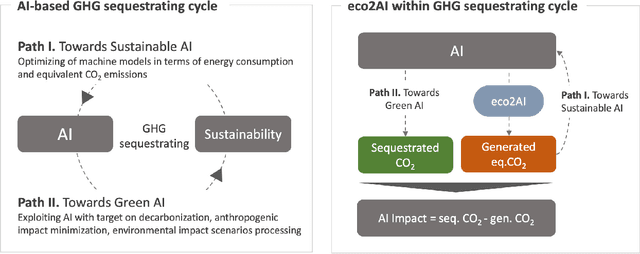
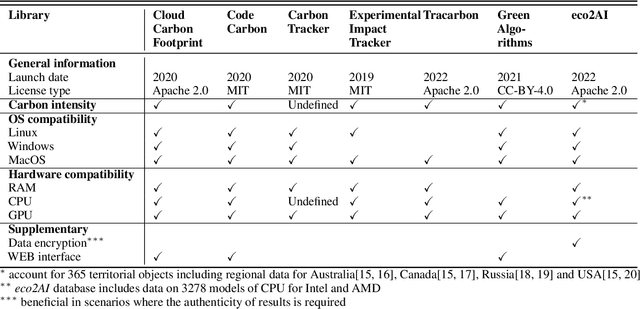


Abstract:The size and complexity of deep neural networks continue to grow exponentially, significantly increasing energy consumption for training and inference by these models. We introduce an open-source package eco2AI to help data scientists and researchers to track energy consumption and equivalent CO2 emissions of their models in a straightforward way. In eco2AI we put emphasis on accuracy of energy consumption tracking and correct regional CO2 emissions accounting. We encourage research community to search for new optimal Artificial Intelligence (AI) architectures with a lower computational cost. The motivation also comes from the concept of AI-based green house gases sequestrating cycle with both Sustainable AI and Green AI pathways.
Many Heads but One Brain: an Overview of Fusion Brain Challenge on AI Journey 2021
Nov 22, 2021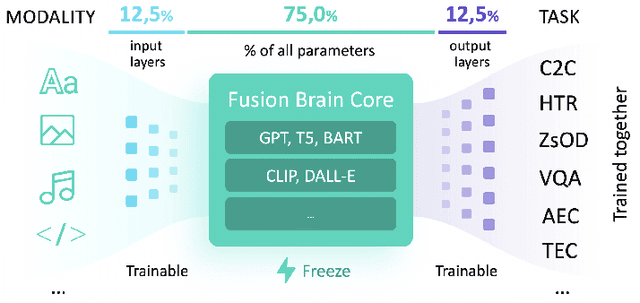
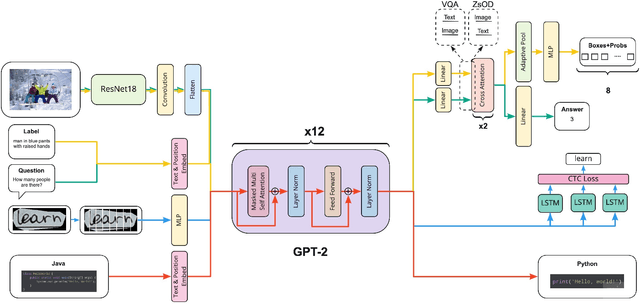
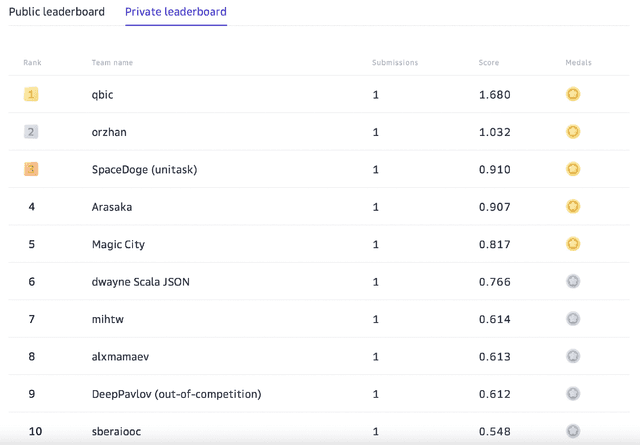
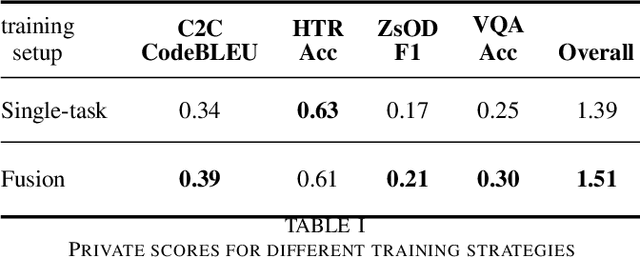
Abstract:Supporting the current trend in the AI community, we propose the AI Journey 2021 Challenge called Fusion Brain which is targeted to make the universal architecture process different modalities (namely, images, texts, and code) and to solve multiple tasks for vision and language. The Fusion Brain Challenge https://github.com/sberbank-ai/fusion_brain_aij2021 combines the following specific tasks: Code2code Translation, Handwritten Text recognition, Zero-shot Object Detection, and Visual Question Answering. We have created datasets for each task to test the participants' submissions on it. Moreover, we have opened a new handwritten dataset in both Russian and English, which consists of 94,130 pairs of images and texts. The Russian part of the dataset is the largest Russian handwritten dataset in the world. We also propose the baseline solution and corresponding task-specific solutions as well as overall metrics.
 Add to Chrome
Add to Chrome Add to Firefox
Add to Firefox Add to Edge
Add to Edge